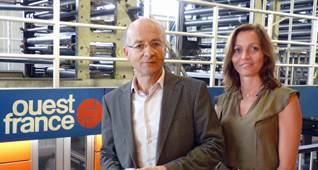Top French Newspaper Printer Achieves Accurate Color with Little Need for Manual Press Monitoring
Press release from the issuing company
Sussex, Wisconsin, USA – Ouest-France, the publisher of France's most widely-read newspaper, has chosen QuadTech’s Digital Ink System to control ink volume and ensure stability of ink density on two new KBA offset presses at the company's Rennes (Brittany) plant.
The investment in the new 48-page, 1400mm-wide presses, capable of a maximum speed of 84,000 copies/hour and set to replace three Miller NOHAB 48 page presses from 1980, is part of an initiative by the newspaper to enhance productivity and efficiency.

Mr. Émile Hédan, Industrial Director, Ouest-France (left)
and Ms. Caroline Zimmer, Regional Sales Manager, QuadTech
QuadTech’s Digital Ink System is a gearless, volumetric alternative to the open fountain system as a way of supplying ink to the keys. It features digital ink injectors that precisely control ink flow and set image density by metering the ink volume of each key. Digital volume metering eliminates the need for setting the fountain blade assembly and pickup roller. Removing the need for gap setting improves reliability, lowers maintenance costs, and produces a more consistent image density through the entire print run, avoiding the fluctuations characteristic of open fountains. Because nothing is touching the fountain ball, the costs of recalibrating and replacing worn ink keys and fountain balls are eliminated.
Ouest-France has benefited from digital ink injection for several years. The company chose the QuadTech system, which is based on ink injection technology developed by CGI, acquired by QuadTech in 2012 and whose units are installed on existing presses at Rennes, Angers and Nantes.
Mr. Émile Hédan, Industrial Director of Ouest-France, comments: "Installing QuadTech's Digital Ink System for our new KBA presses was a natural choice because our people are familiar and skilled with the system, enabling us to smoothly transition to the new printing press without the need to retrain staff."
He continues: “We are impressed by the ability of the Digital Ink System to inject the exact amount of ink required . This helps the press reach density targets very quickly as it accelerates, thus minimizing start-up waste. Furthermore, the system maintains ink stability throughout the printing run. This gives us reassurance of being able to achieve accurate color, with little need for manual press monitoring, even in situations of variable printing speeds.”
In addition, the Digital Ink System provides improved cost control because the printer can calculate accurate consumption rates. Its enclosed construction also keeps clean ink protected from contamination.
The Digital Ink System’s precision is achieved thanks to servo stepping motors—powered by an embedded microprocessor—which drive rotary pumps that in turn deliver ink to the rollers. The system is connected to the press speed so that as the press accelerates, the pump keeps delivering ink at the required rate. The microprocessor makes changes almost instantly. Thus, a precise amount of ink is delivered to the ink zone, over a wide range of ink pressures and press speeds.
While Ouest-France is taking delivery of the QuadTech systems on new presses, the Digital Ink System is also retrofittable onto existing presses.
With 2.5 million daily readers (and a circulation of almost 800 000 units) across Brittany, Normandy and Pays-de-la-Loire regions in France, Ouest-France is the most widely-read French-language newspaper in the world. The Rennes plant publishes 53 localized editions in the week and 16 editions on Sundays.
© 2025 WhatTheyThink. All Rights Reserved.














Discussion
By Erik Nikkanen on Nov 27, 2013
An example that print variation is not an inherent part of the offset process. Print consistency, that does not need much manual monitoring, is very much related to the consistency of the ink feed.
There is still much room for improvement with this old process. :-)